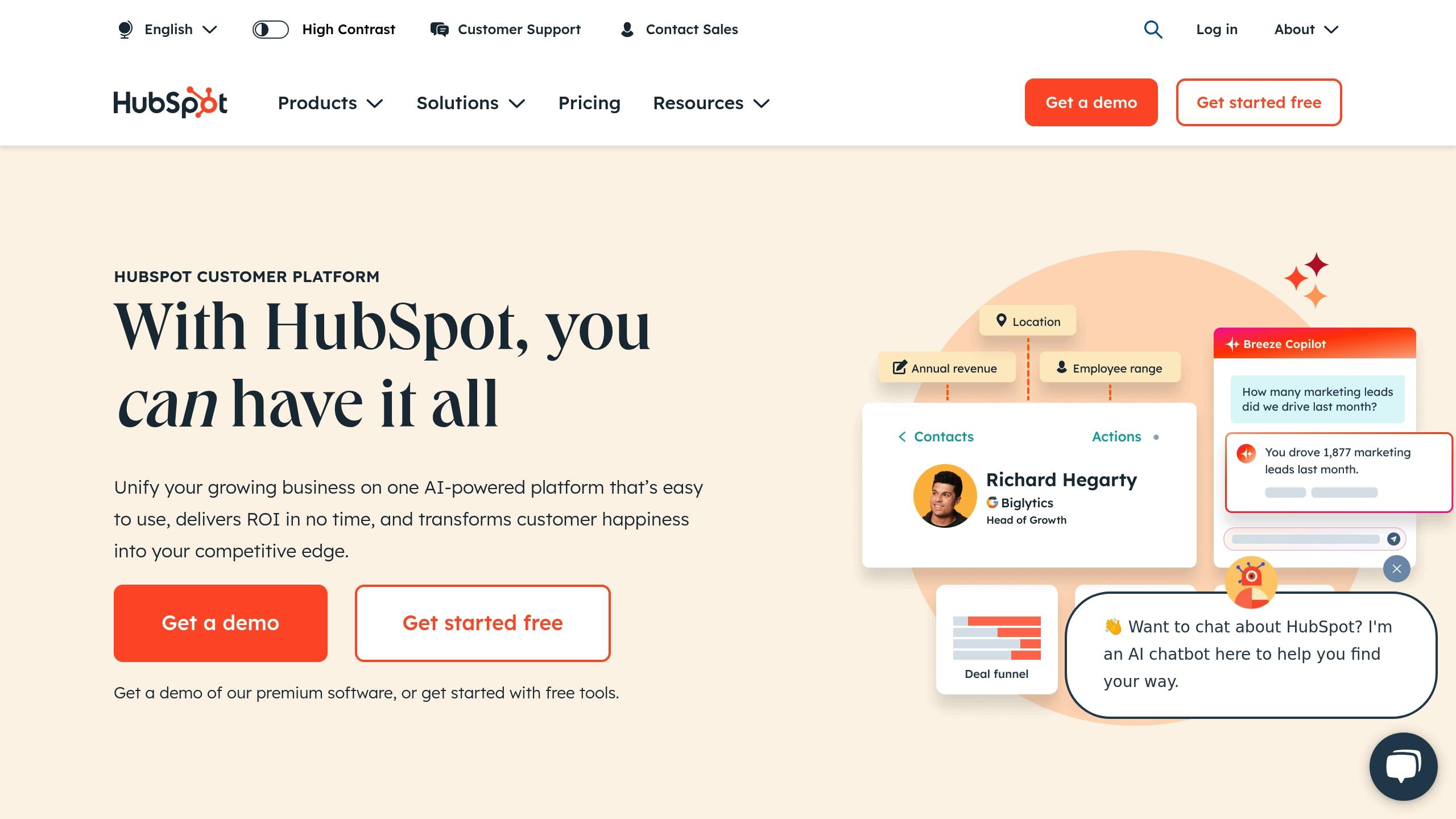5 SaaS Marketing Case Studies: Growth Lessons Learned
Explore how leading SaaS companies utilized innovative strategies like freemium models and referral programs to achieve remarkable growth.

SaaS companies thrive with smart marketing strategies. This article explores five standout case studies - Slack, Dropbox, HubSpot, Zoom, and Canva - and the tactics they used to achieve massive growth. Here's a quick summary of what you'll learn:
- Slack: Built a strong community with a freemium model and user referrals.
- Dropbox: Leveraged a double-sided referral program to scale quickly.
- HubSpot: Educated the market through targeted content marketing.
- Zoom: Focused on simple, reliable video calls to dominate the market.
- Canva: Made design tools accessible with an easy-to-use freemium platform.
Each case shows how strategies like referral systems, content marketing, and user-focused design drive growth. Dive in to see how these companies achieved success and what you can learn from them.
Case Study 1: How Slack Built Its User Community

Early Market Challenges
When Slack entered the team communication market in 2013, it faced tough competition. The space was already filled with established tools, and email was still the go-to method for workplace communication. Instead of blending in, Slack took a bold stance by calling email its "enemy" and focusing on measurable productivity gains. The goal? Reduce internal emails by 32% and cut meetings by 27%. To avoid the stigma often tied to beta launches, Slack introduced a "preview release" instead. These early hurdles pushed Slack to adopt a freemium model and a referral-driven approach.
Freemium and User Referrals
Slack's freemium model was key to its growth. By offering the platform for free, Slack removed any barriers for teams to start using the tool. Here’s how the free plan worked:
| Feature | Free Plan Value | Business Impact |
|---|---|---|
| Message History | Limited but functional | Let teams explore core features |
| App Integrations | Basic set included | Highlighted the platform's flexibility |
| Storage | 5GB team storage | Enough for small teams to evaluate |
| Customer Support | Standard support | Built trust through quick responses |
Slack also focused on small teams within larger organizations, encouraging grassroots adoption of the tool.
"We wanted Slack to be something people would introduce to their colleagues without needing a salesperson to convince them"
Growth Results
This strategy paid off quickly. Within 24 hours of its preview release, Slack had 8,000 users. Two weeks later, that number jumped to 15,000, and by the end of its first year, it had 285,000 daily active users. By 2020, Slack had grown to over 12 million daily active users.
"The strength of Slack is that it fits into whatever workflow you already have - it doesn't require you to change the way you work" – Stewart Butterfield
Word-of-mouth played a massive role in this growth. Research shows that 92% of people trust recommendations from friends and family more than any other form of advertising. Slack leaned into this by creating a "Wall of Love" on Twitter, where they showcased user testimonials. They responded to every message, using feedback to refine the platform and build loyalty. This focus on community helped Slack achieve a major milestone: a $1.1 billion valuation before even hiring a Chief Marketing Officer.
Case Study 2: Dropbox's User Referral System

Entering the Cloud Storage Market
When Dropbox stepped into the cloud storage market in 2008, it faced stiff competition. Instead of relying on traditional advertising channels that could cost $233–$388 per user acquisition, Dropbox turned to its own users as a powerful marketing tool.
Double-Sided Referral Program
Dropbox's referral program became a game-changer. It offered rewards to both the person making the referral and the new user. Here’s how it worked: Basic users earned 500 MB of free storage per referral (up to 16 GB), while Plus users received 1 GB per referral (up to 32 GB). This incentive was perfectly aligned with what users valued - more storage. Unlike competitors that handed out cash rewards, Dropbox gave away what it did best: its storage service. This approach not only kept costs manageable but also reinforced the product's value.
The Impact on Sign-Ups
The referral program wasn’t just a clever idea - it delivered results. Dropbox grew from 100,000 users in September 2008 to 2.2 million by September 2009, and by the end of 2010, it had reached 4 million users. During the first 15 months, referrals drove 35% of daily sign-ups. In April 2010 alone, users sent 2.8 million referral invites. Fast forward to 2020, Dropbox had scaled to 700 million users, including 15.48 million paying customers.
Dropbox made the referral process seamless by integrating it into the user experience. From onboarding to an easy-to-use referral dashboard, strategic thank-you emails, and multiple sharing options, the system minimized barriers for users. This strategy highlights how an effective referral program can fuel consistent growth in the SaaS world.
Case Study 3: HubSpot's Content Marketing Success

Market Education Needs
When HubSpot entered the market, many potential customers didn’t fully understand inbound marketing. To address this, HubSpot positioned itself as a trusted source of knowledge for marketers, focusing on education instead of relying on traditional sales methods.
Educational Content Program
HubSpot created a well-planned, multi-channel content strategy to reach its audience effectively. Here’s what they did:
- Specialized Blog Categories: Their blog was divided into clear sections - Marketing, Sales, Service, and Website - helping visitors quickly find the content they needed.
-
Targeted Newsletters: HubSpot launched newsletters tailored to specific audience groups:
- The Lead: Weekly updates on marketing news and insights.
- The Hustle: Focused on business and tech news.
- HubSpot Community Newsletter: Featuring weekly webinars and beta opportunities.
- HubSpot Partner Digest: Monthly updates for partners.
- Video Tutorials: Since starting their Marketing YouTube channel in 2007, HubSpot has shared over 400 free marketing tutorials.
These efforts helped HubSpot improve both lead generation and conversion rates.
Lead Generation Results
HubSpot’s strategy is evident in its client success stories. Take PatSnap, for example - a company offering innovation intelligence. They began using HubSpot’s platform in 2016.
"I come from a sales background myself, and I wanted to show our sales team that marketing isn't arts and crafts... My goal was to demonstrate how we could track every step from captured lead to closed deal supporting sales teams along the way to build trust." - Ade Risidore, Marketing Director, PatSnap
PatSnap saw impressive improvements after adopting HubSpot:
| Metric | Improvement |
|---|---|
| Lead Generation | 400% increase |
| Organic Traffic | 23% monthly growth |
| Social Media Traffic | 30% increase |
| Marketing Lead Conversion | 33% (compared to 20% from other sources) |
| Sales Cycle Duration | Reduced from 38 to 24 days |
Their approach? Offering high-value resources - like webinars, whitepapers, and reports - on landing pages with clear calls-to-action. This strategy highlights how well-crafted educational content can drive both lead generation and sales efficiency in SaaS businesses.
Case Study 4: Zoom's Focus on Ease of Use

Video Call Market Entry
When Zoom entered the video conferencing market, it faced tough competition from big names like Google Hangouts, GoToMeeting, and WebEx. Instead of trying to outdo them with a long list of features, Zoom zeroed in on delivering reliable, high-quality video calls that were simple to start and join.
Their approach was anything but typical - Zoom didn’t even hire its first marketer until 2015, when it had already reached $7 million in annual recurring revenue. Instead, they relied on the product's simplicity to spread through word-of-mouth recommendations.
User Experience Improvements
Zoom's rise can be attributed to several key upgrades in user experience that made it stand out:
| Feature Area | Zoom's Advantage |
|---|---|
| Core Technology | Stable video calls with top-notch audio/video quality |
| Platform Access | Works seamlessly across browsers and devices |
| Meeting Management | Advanced host controls and easy screen sharing |
| Audio Quality | Noise reduction and personal audio isolation |
| Accessibility | Live transcription and support for multiple languages |
Zoom managed to keep things simple without sacrificing functionality. They introduced AI-powered tools like their AI Companion, which provides meeting summaries and supports in-meeting questions in multiple languages. Another standout feature, Zoom Mesh, reduced bandwidth usage by up to 80%, ensuring smooth performance even on slower internet connections.
"The good part of Zoom's user experience doesn't lie in its interface - it's in the primary activity the product is for: video meetings. Incidentally, that's over 90% of the experience, if you look at the total time."
These user-friendly improvements directly fueled Zoom's success in the market.
Market Share Growth
Zoom's focus on user experience paid off in extraordinary ways:
- Market share: Reached about 57%
- Daily meeting participants: Jumped from 10 million to 300 million in just four months during 2020
- Revenue: Hit $4.3 billion in 2022
- Mobile usage: Over 50% of users accessed Zoom on mobile devices by 2020
The platform's success was also reflected in user satisfaction. A 2022 study showed Zoom achieving a positive Net Promoter Score, while competitors struggled with record lows. Zoom also ranked highest in perceived usability, earning a grade B on the System Usability Scale.
"We didn't design the product with the knowledge that, in just a few weeks, the entire world would be using it." - Eric Yuan
Zoom’s rapid growth culminated in a blockbuster IPO in April 2019, with the company valued at $9.2 billion. Its stock price surged over 72% on the first trading day, closing at $62, up from the initial $36 per share. By 2020, Zoom's market cap had soared past $100 billion, proving that prioritizing ease of use can drive phenomenal business success.
Related video from YouTube
Case Study 5: Canva's Mass Market Design Tools

Canva's rise as a SaaS leader stems from its focus on making design tools accessible to everyone, not just professionals.
Simplifying Design for Everyone
When Canva launched, most design software was expensive and complicated, leaving non-designers out of the equation. Canva changed that with its easy-to-use drag-and-drop interface, allowing anyone to create polished designs without prior experience.
The company prioritized three main features to make design more accessible:
| Feature | Benefit for Users | Impact |
|---|---|---|
| Drag-and-drop Interface | Easy for beginners to use | Enables instant design creation |
| Pre-designed Templates | Ready-made starting points | Speeds up the design process |
| Extensive Asset Library | Built-in design elements | Removes the need for external tools |
Cameron Adams, Canva’s Chief Product Officer and Co-Founder, explained: "People are looking for new ways to communicate. They need to cut through the flood of information that's coming in now. [Whether you're working on a small or large team] you need to communicate your ideas and rally people and get them behind you".
This user-first approach laid the foundation for Canva's freemium model, which helped the platform gain traction quickly.
Freemium Model and Rapid Growth
Canva revolutionized the design software market with its freemium model. The free tier includes thousands of templates, images, and graphics, offering significant functionality without cost.
Here’s an overview of Canva’s pricing:
- Free tier: Includes access to over 250,000 templates and essential design tools.
- Canva Pro: Priced at $119.40/year or $12.95/month, offering advanced features.
- Enterprise: Custom pricing tailored for larger organizations.
"One of the smartest things Canva does is let you use a ton of its features for absolutely free. This is what's called a 'freemium' model." - Rishikesh Ranjan
By removing barriers to entry, Canva attracted millions of users and turned many into paying customers.
Explosive Growth and Global Reach
Canva’s commitment to simplicity and quality has driven its stunning growth. Key milestones include:
- Active Users: 180 million monthly users worldwide
- Designs Created: Over 20 billion designs made on the platform
- Revenue: Annual revenue exceeding $1.7 billion
- Global Presence: Available in nearly 190 countries
- Education: Over 60 million students and teachers use Canva for free
Canva continues to evolve with its Visual Worksuite, which now includes tools like Canva Docs, Websites, and Whiteboards. These additions strengthen its role as a go-to design solution for individuals, educators, and businesses alike.
Main Growth Lessons
Shared Success Factors
The case studies highlight effective strategies that have driven business growth. These approaches combine various methods to create impactful growth engines.
| Growth Strategy | Success Metric | Company Example |
|---|---|---|
| Content Marketing | 3x increase in leads | Buffer's journey to $20M ARR |
| Referral Programs | 8,000 signups on launch day | Slack's early word-of-mouth launch |
| Freemium Model | $625K in gross revenue | Semrush's affiliate program |
| User Experience | 4x growth in new business subscribers | Holded's Black Friday campaign |
Implementation Steps
These strategies can be translated into actionable steps you can start using right away:
-
Start with Product-Led Content
Develop content that naturally highlights your product's solutions. For example, HubSpot segmented its content to meet the needs of different audience groups, which contributed to its growth. -
Build a Strategic Referral System
Create a referral program that rewards both referrers and new users. As Leo Widrich, Buffer's co-founder, shared:"Up until the past 2 months, content marketing accounted for 70% of our daily signups. This is just a great way to provide value for readers, without full self-promotion".
-
Optimize Your Pricing Structure
Design pricing tiers that are clear and align with the value customers receive. Holded, for instance, used a strategic pricing approach during its Black Friday campaign, boosting Monthly Recurring Revenue by 6% and quadrupling new business subscribers.
Key Metrics to Track
To assess the success of these strategies, focus on the following metrics:
| Metric | Target Range | Why It Matters |
|---|---|---|
| Customer Lifetime Value to CAC | 3:1 ratio | Ensures profitability |
| Monthly Churn Rate | 5-7% | Benchmarked for industry standards |
| Net Revenue Retention | >100% | Reflects strong product-market fit |





